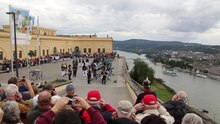cannon
Cannon is originally the name for a gun that is used both in artillery (terrestrial artillery , ship artillery , anti-aircraft artillery ) and for aircraft (on- board cannon also machine cannon) and tank armament ( combat vehicle cannon or tank cannon ). The tube length is at least twenty times the caliber ( caliber length L ). In the military system of the former Warsaw Pact, the cannon of the earth artillery was defined as a flat fire gun with a barrel elevation of up to + 40 ° and a barrel length of over 30 to 70 calibers.
Today the cannon is regarded as a flat fire gun , which, in contrast to the steep fire gun ( howitzer , mortar , rocket launcher or grenade launcher ) is primarily used in direct fire combat (including direct aiming). Further weapon systems derived from the cannon are, for example, field cannon, anti-aircraft cannon , hunting cannon, cannon howitzer, anti-tank cannon, anti-tank cannon , ship cannon and assault gun ( assault cannon).
Colloquially, no distinction is made between the terms gun and cannon , although gun is a generic term that includes cannons as well as mortars and howitzers .
Etymology and history
The term comes from the Italian word canna (like French canon ) for "tube" or "pipe", which is expanded to cannone with an augmentative ending . The underlying Latin word canna is itself a takeover from the Greek, where κάννα (kanna) means pipe . Guns have been around under various names in the German-speaking world since the 14th century . The term cannon did not become common in German until the 17th century. A distinction between the cannon, howitzer and mortar types can be proven in the late 18th century.
In the early days, the type of ammunition used and the caliber length were the main distinguishing criteria. Cannons fired solid shot at close range and grapeshot in direct income. The howitzers, invented in 1683, fired bullet grenades with time fuses in direct and light archery fire, and mortars fired those in steep fire. Howitzers and mortars used to be referred to as chamber pieces, as the rear end of the tube core, the powder chamber, was reduced in diameter. Chamber guns have a two-part barrel.
Today's cannons
Modern cannons are flat-fire guns with an elevation possibility of up to about 35 °. Since they give the projectile a straight trajectory due to the high muzzle velocity, they can be used for indirect fire and direct shot. In contrast to this, howitzers (elevation up to 75 °) and mortars are used as high- angle fire guns for indirect fire , with howitzers also allowing direct fire for close-range defense.
The anti-tank guns were replaced by the lighter and more mobile anti-tank guided weapons because of their ineffectiveness compared to the modern armor .
The term cannon is still used today for the main weapon (also combat vehicle cannon ) of battle tanks , the anti-aircraft cannon or smaller automatic cannons . In military technology , the term is also used for lasers and electromagnetic cannons such as railgun and coilgun used as weapons .
Soviet 45mm anti-tank gun M1937
- German chariot cannon
Cannon fire on the USS Iowa
Phrase
The term cannon is associated with idioms and metaphors such as cannon fodder or sports cannon .
See also
Web links
Individual evidence
- ^ Dictionary of German military history, 1st edition (Liz.5, P189 / 84, LSV: 0547, B-Nr. 746 635 0), Military Publishing House of the GDR (VEB) - Berlin, 1985, Volume 1, p. 325 - " Cannon".
- ↑ Duden. The dictionary of origin. ISBN 3-411-20907-0 . Page 324 sv canal . As the references in Karl Ernst Georges ( Detailed Latin-German Concise Dictionary , Volume 1, Columns 959 f.) Show, the takeover happened in the 1st century.
- ^ Franz Harder : Becoming and Wandering Our Words, 1897, page 79 ( online in the Google book search)
- ^ Imperial-Royal Engineering Academy: Treatise on the art of fastening, Volume 1 , Verlag Thomas von Trattner , 1795, p. 29 [1]




